Asian Ceramics
Introduction
Text-to-speech Audio
The collection contains over 250 pieces of Asian ceramics. This Japanese porcelain “rabbit bowl" decorated with bright colored glazes and distinctive designs is known as Imari ware throughout the world. It was shipped from Imari but made in Arita, and the two names are interchangeable. Although Imari ware is perhaps the most well-known of Japanese ceramics, the Howard and Asian Art Collection is so rich in examples from other Japanese schools that this tour will concentrate on Japanese ceramics. However, several Chinese objects in the nearby Elynna and Henry Schaffner Display Case and a few pieces of Korean pottery in the hallway Lois and James Pott case are included...
If you stand in the foyer and look at the whole Kathrine and James Lingle Display Case featuring a selection of the Japanese collection, two markedly different styles are immediately apparent. Those on the left seem very rough and rustic, while others on the right are brightly colored and elegant. The first style relates to nature, with the hand of the potter and the marks of his tools evident. Simple glazed and unglazed stoneware stems from Chinese and Korean traditions, typified by Bizen ware. A second style is typified by raku glazed earthenware and exhibits the tea-ceremony aesthetics of wabi-sabi, meaning “simplicity in daily living” and “appreciation of imperfection.” The third, more refined style, shows the early influence of Chinese porcelain styles. Succeeding generations created porcelain with distinctly Japanese characteristics. A good example of this is found in Imari style porcelain. Generally, Japanese people prefer the simpler styles and westerners the more ornate, like the Kutani and Hirado styles on the far right...
Please click on the first photo to view the slide show.
Images
The potter incised and filled old Chinese characters on this stoneware Bizen sake bottle.
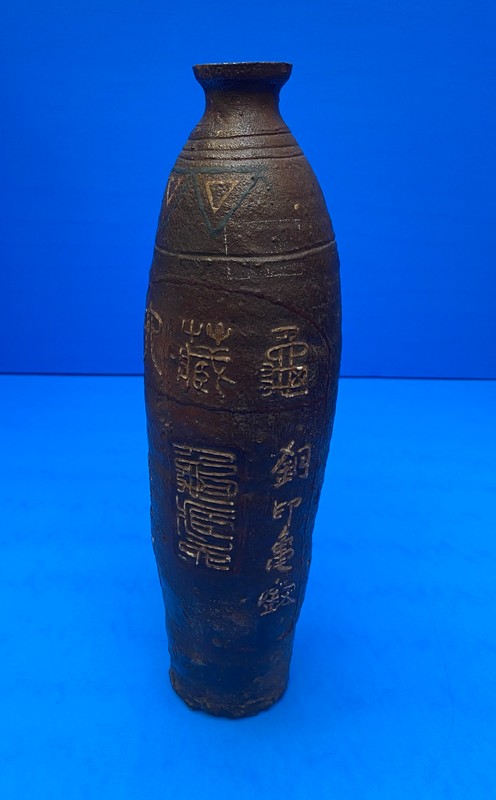
Most sake bottles look like this one with only minimal decoration.
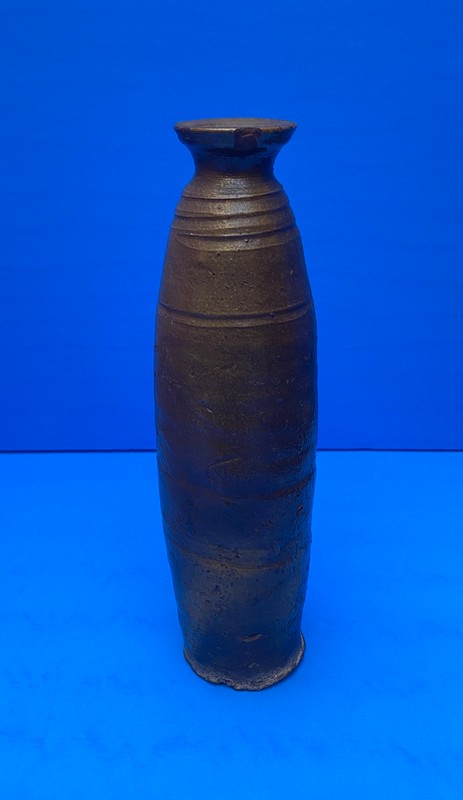
Bizen, not Raku, this bowl shows the roughness of stoneware on its surface.
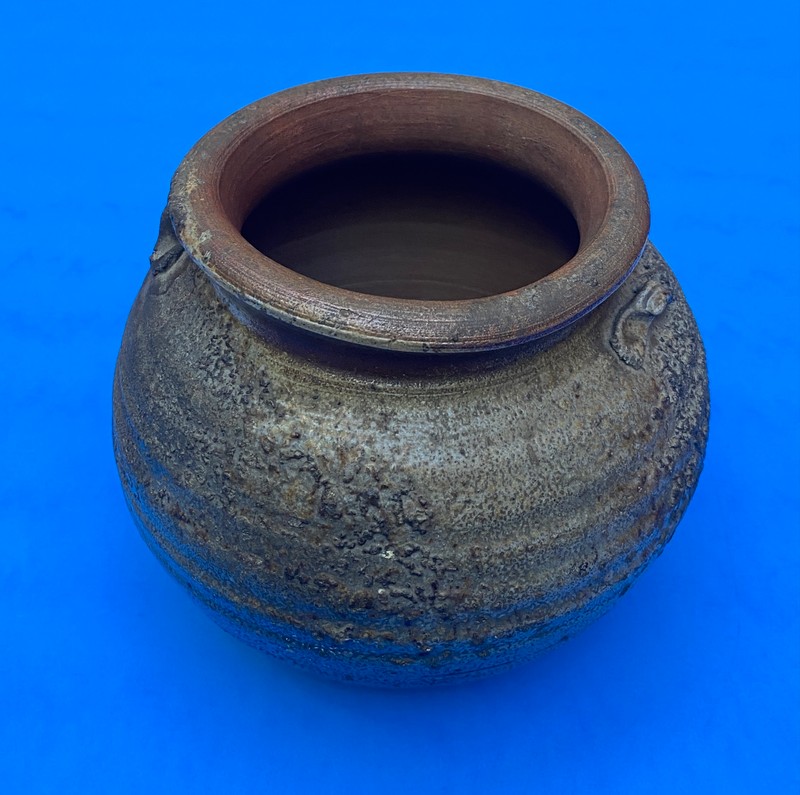
Raku ware epitomizes the art of wabi sabi: simplicity and closeness to nature.
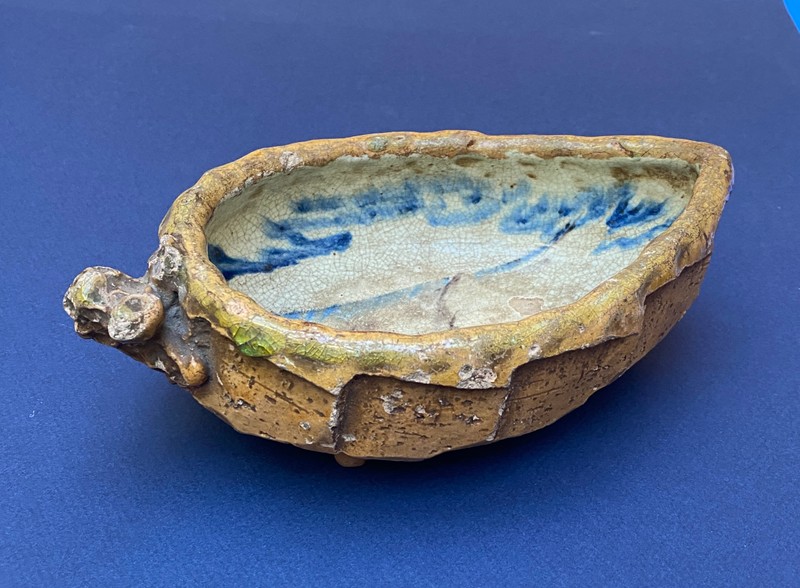
Notice the imagery of Mt. Fuji on this classic earthenware Raku bowl.
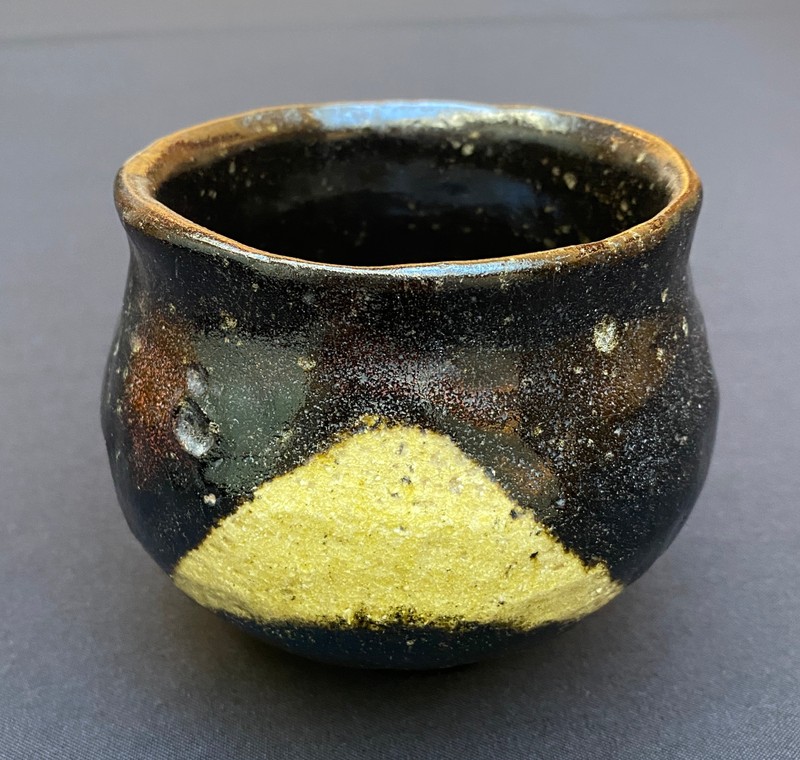
A raku ware tea bowl has sides thick enough to prevent burns from hot tea.
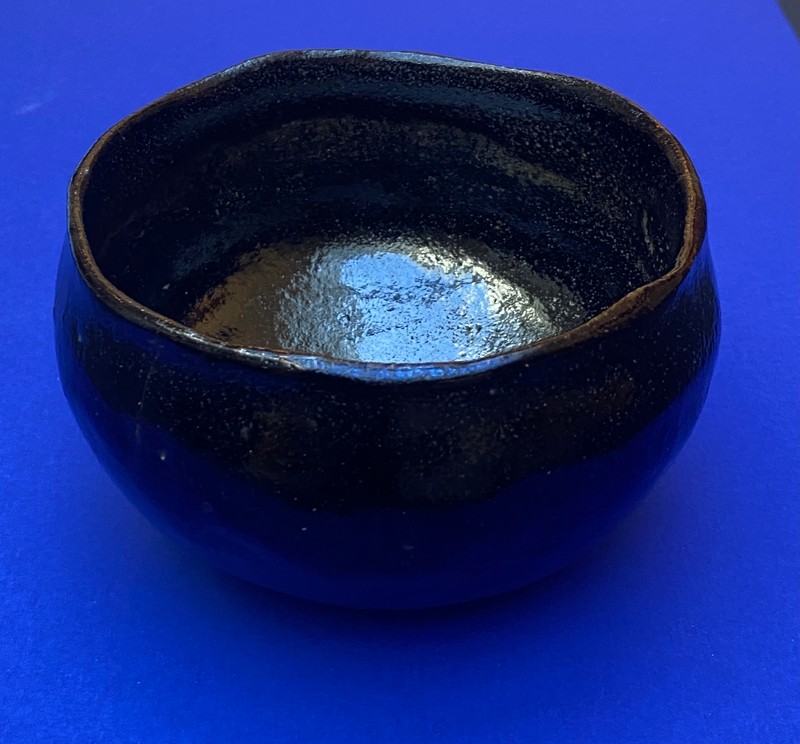
The Mishima bowl created by Takahashi Dohachi shows the style's distinctive, incised decoration.
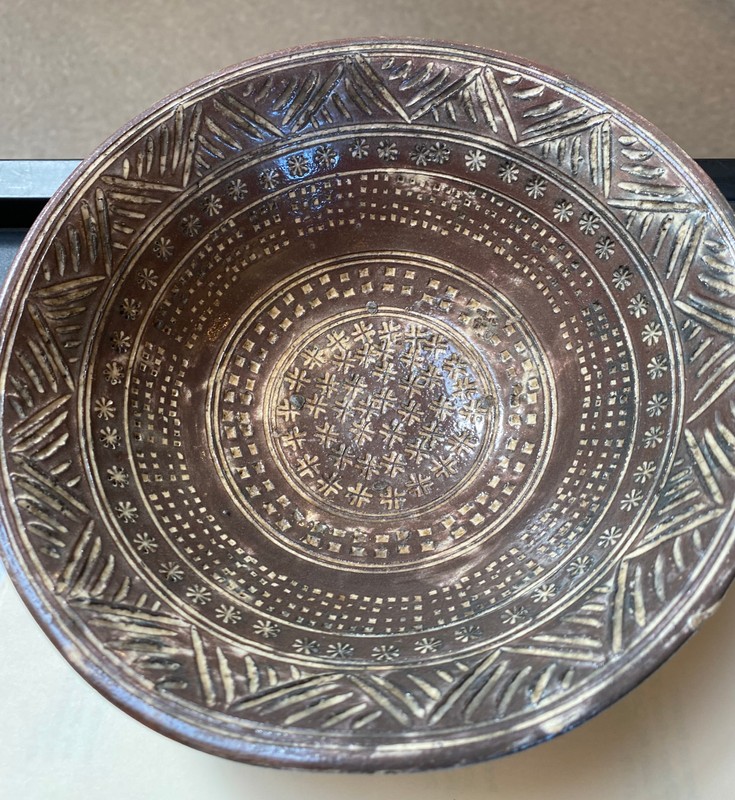
A more modern Mishima bowl showcases the same style of incised lines filled in with thin clay slip.
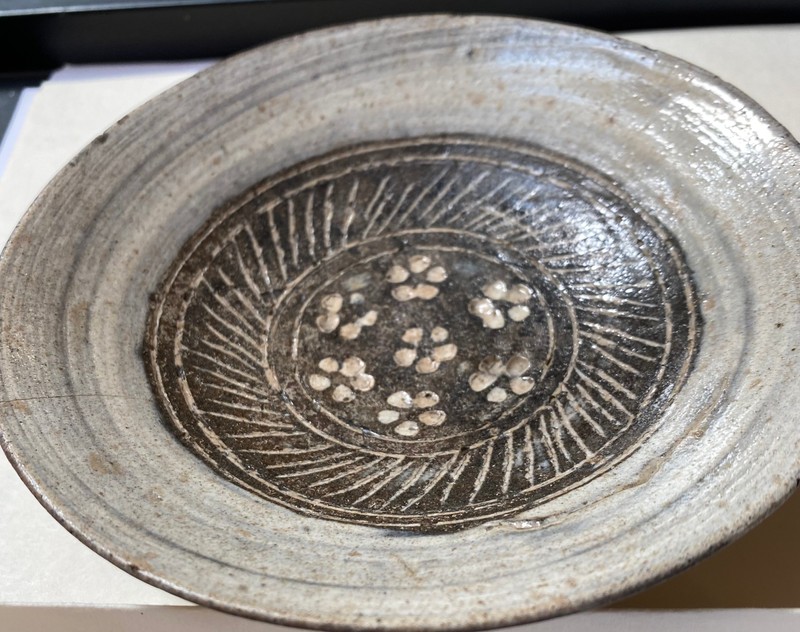
This Satsuma gold plate is embellished with moriage, raised white enamel flowers.
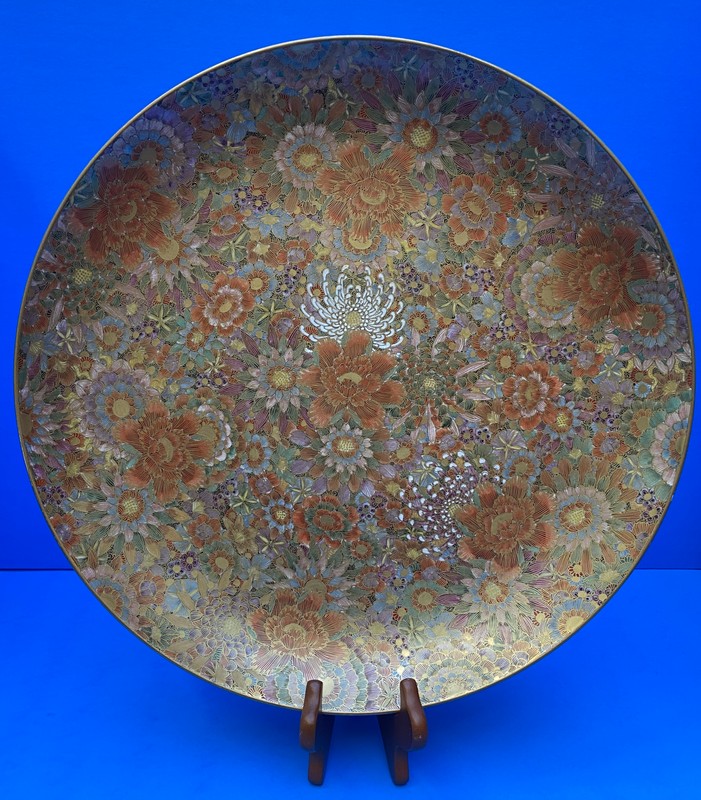
This earthenware bowl with the circle surrounding a gold cross is marked with the crest of Satsuma.
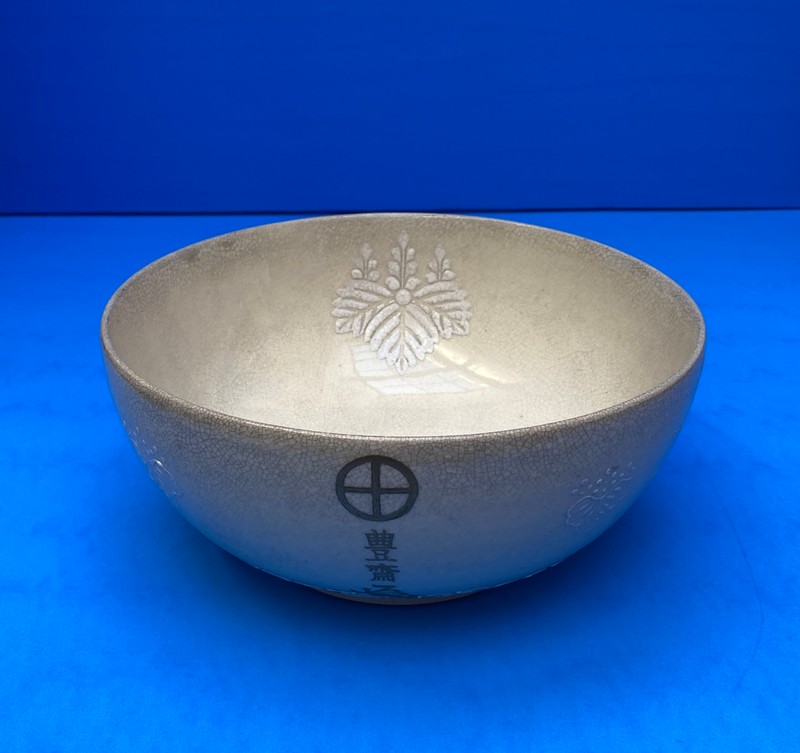
The exquisitely fine painting indicates that this bowl of people in a garden may be from Satsuma's famed Shiraz kiln.
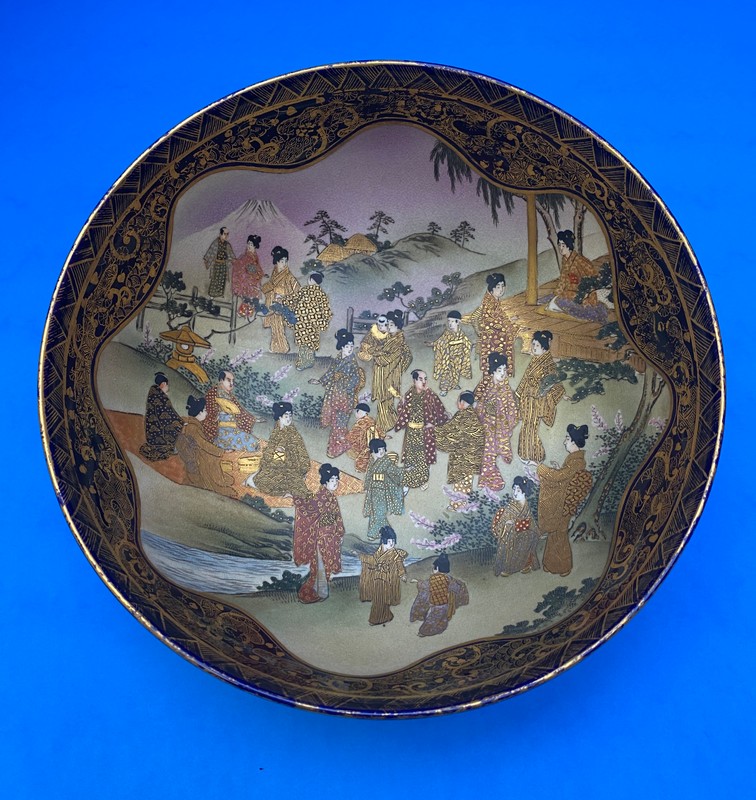
This extraordinary Satsuma decoration appears on an incense burner made of porcelain, not earthenware.
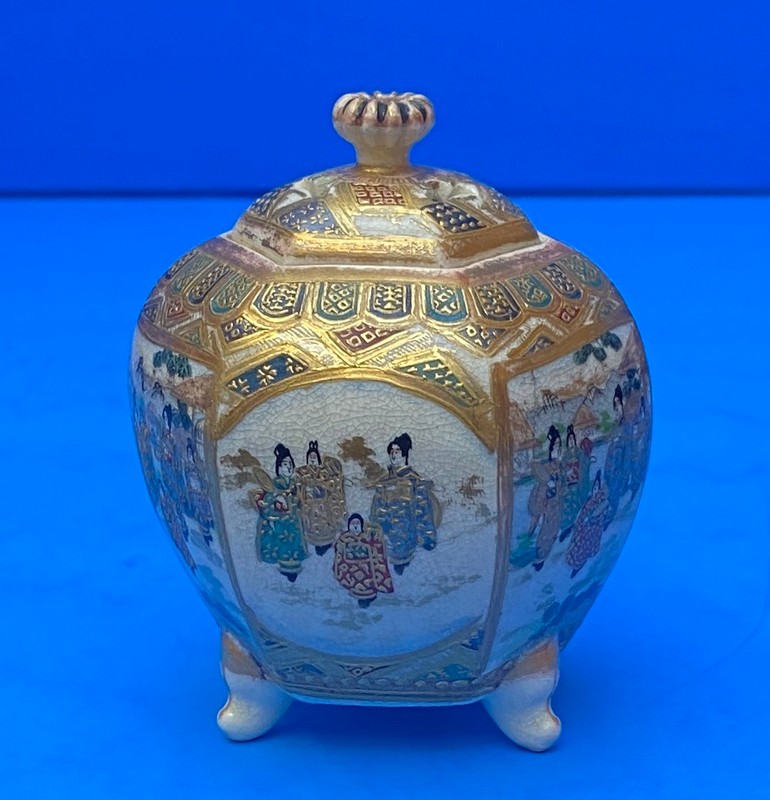
The artistic talents of Satsuma artists are shown on this porcelain vase depicting women with Mt. Fuji in the background.
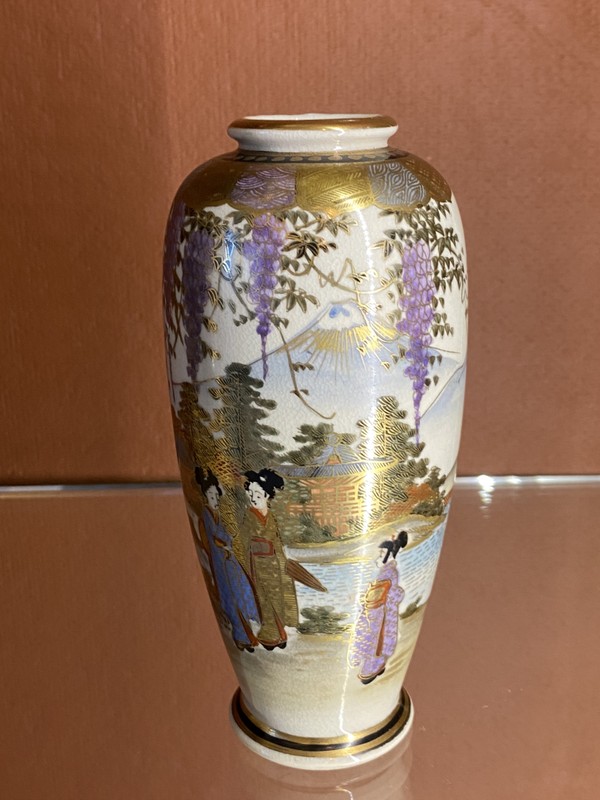
Early Imari was blue and white porcelain, at times with relief decoration, as in the ewer's dragon.
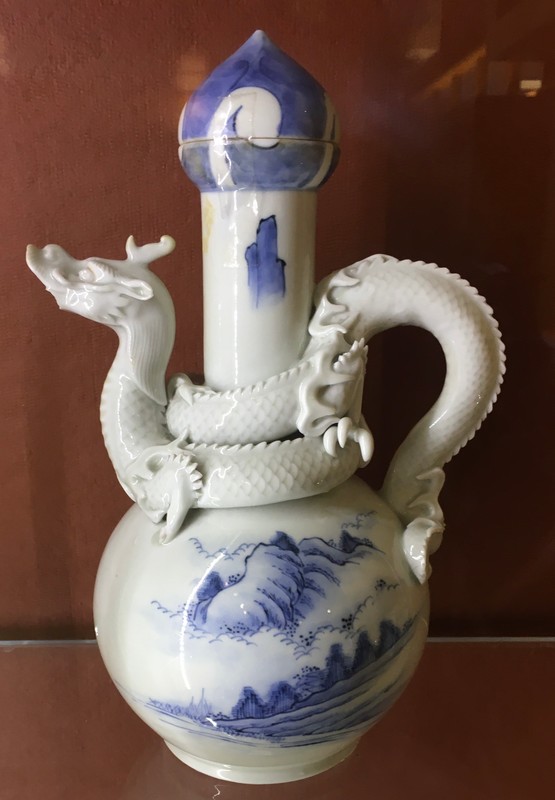
An early blue and white Imari bowl has compartmentalized scenes and patterns.
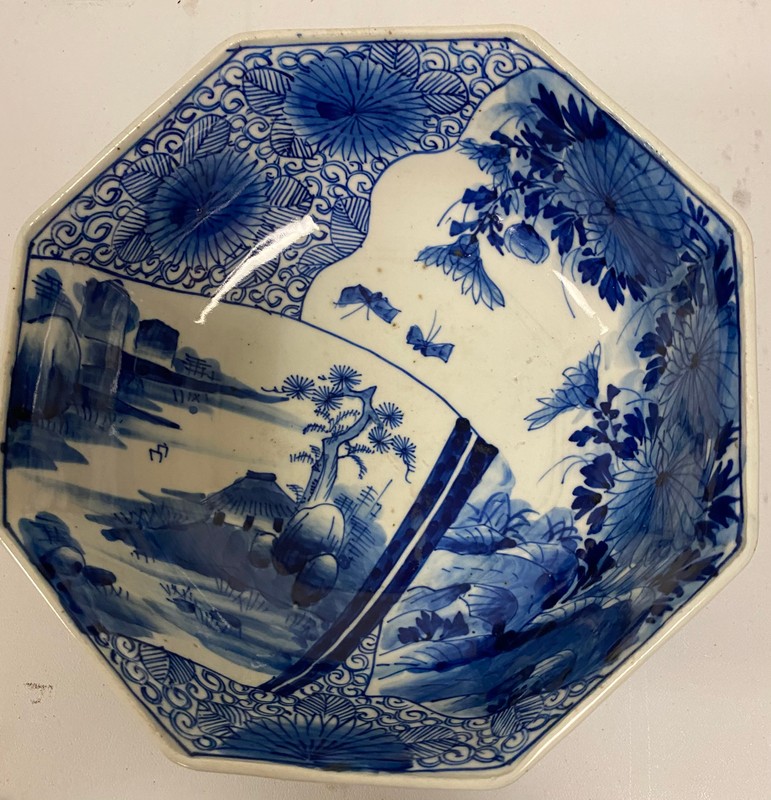
This early blue and white Imari porcelain folk art teapot shows strong influences of Korean ceramics.
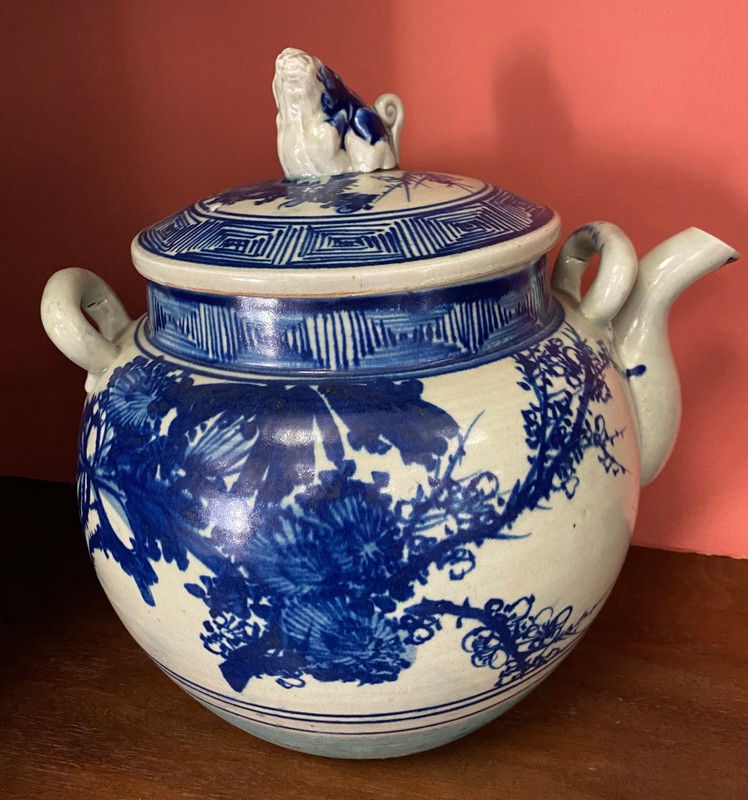
The Imari ware porcelain rabbit bowl may have been a wedding gift to encourage the newlyweds to have many children.
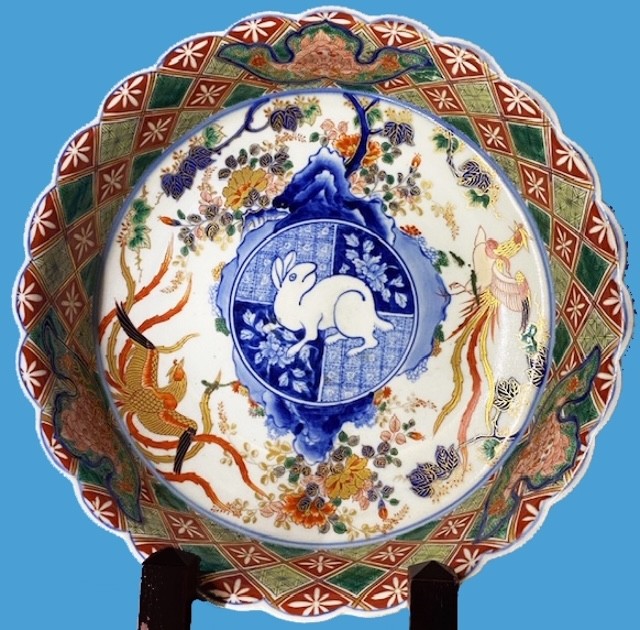
The tortoise and other auspicious symbols for longevity and good fortune decorate this Imari bowl.
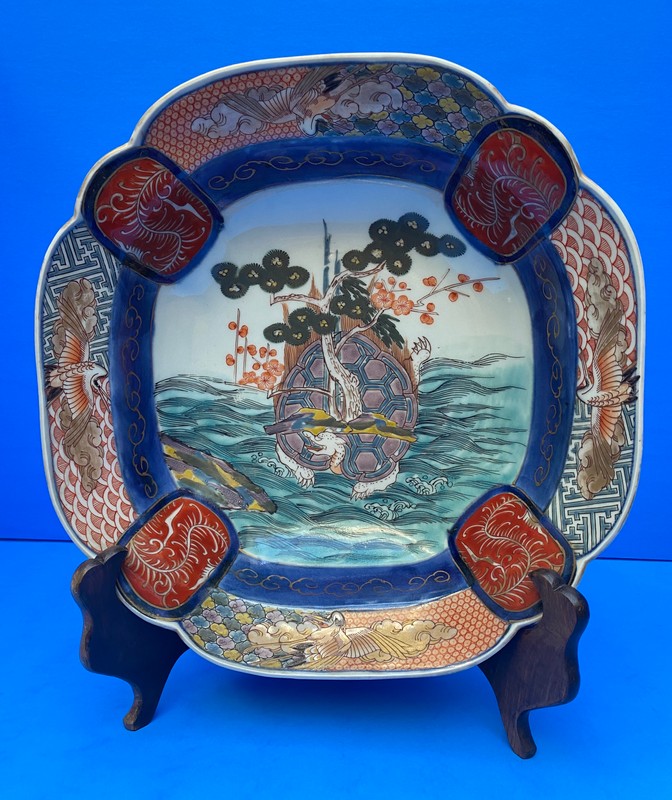
The octagonal Imari bowl is decorated with colors typical of the Imari traditions.
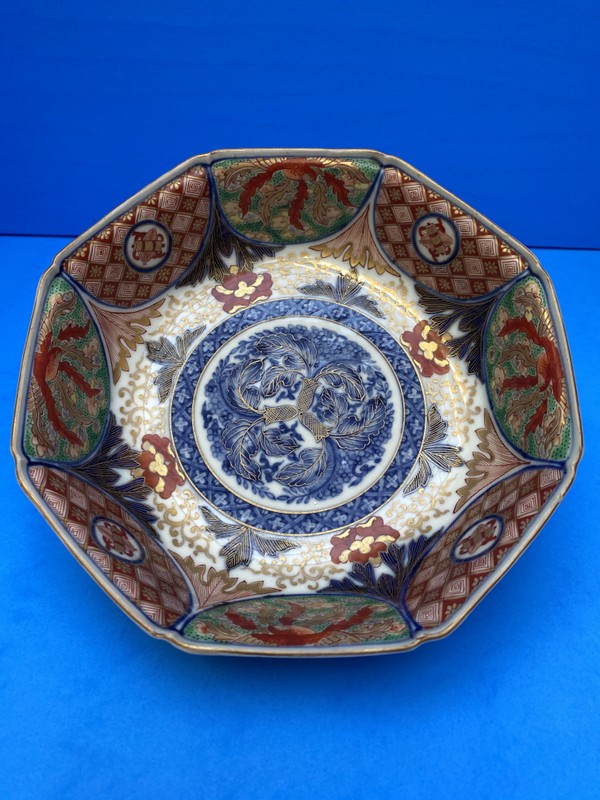
The center of this Imari bowl shows a scene of a room and garden.
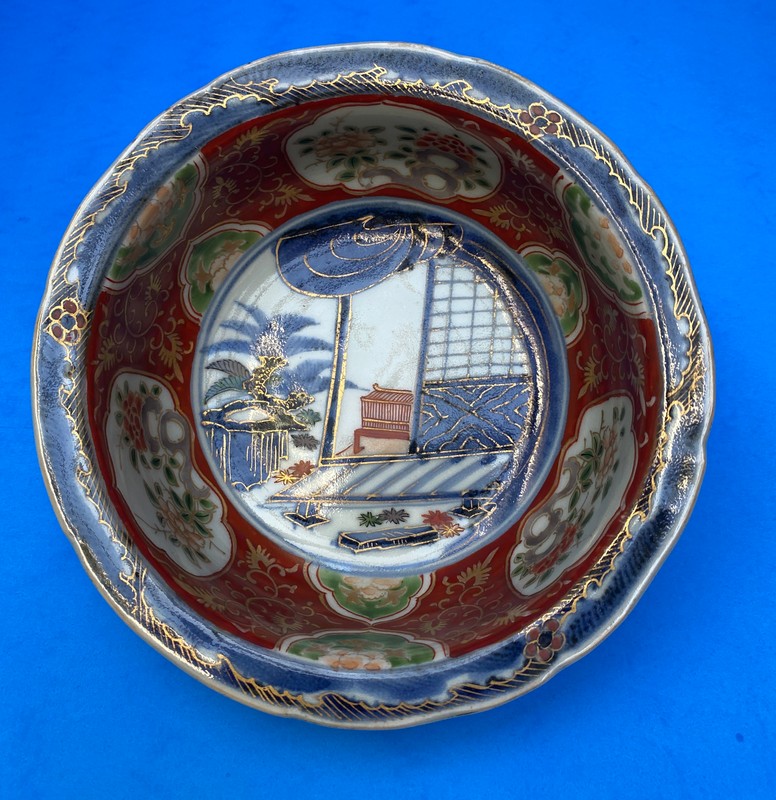
A large Kutani jar decorated with landscape scenes sits on a separate stand.
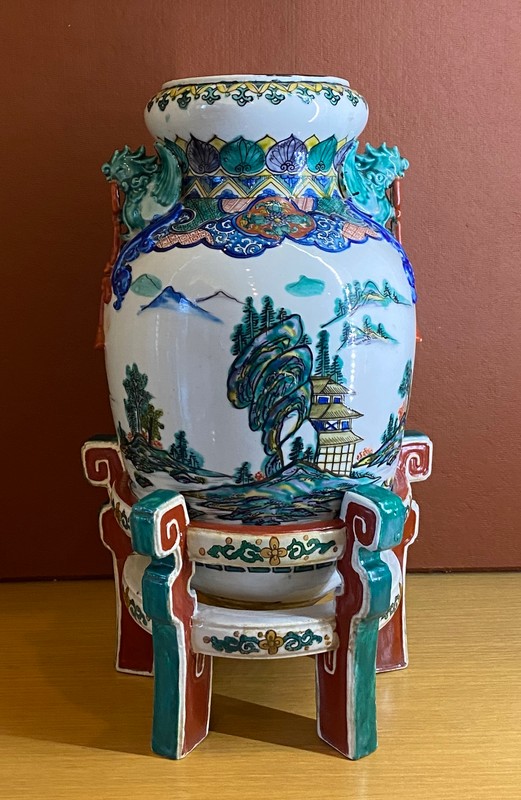
The scene with three Samurai warriors on a Kutani bowl resembles a woodblock print.
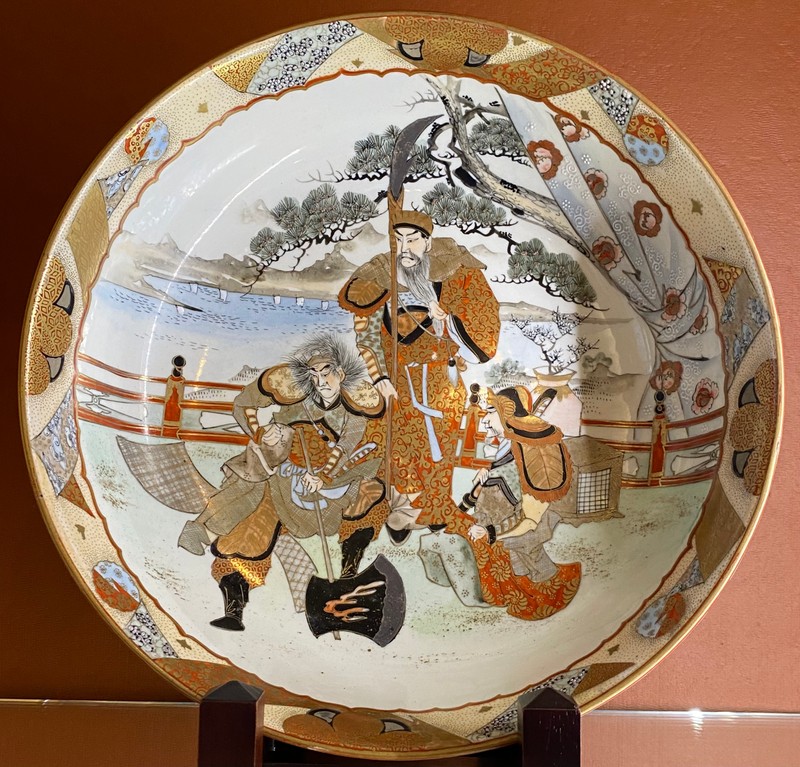
The small cup features horses in action on this Kutani creation.
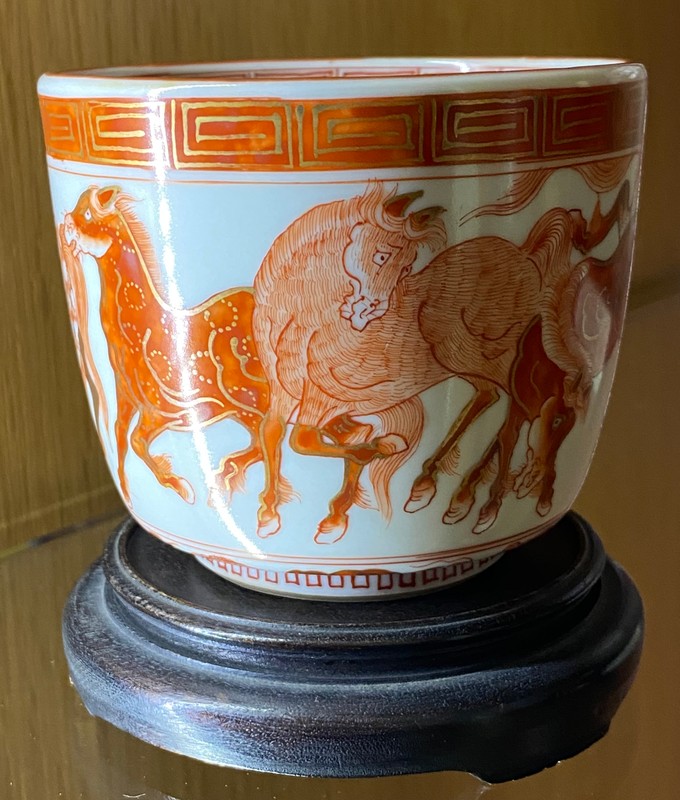
Ebisu and Daikoku, mythical gods of plenty, are pounding rice for mochi in this Kutani folk art piece.
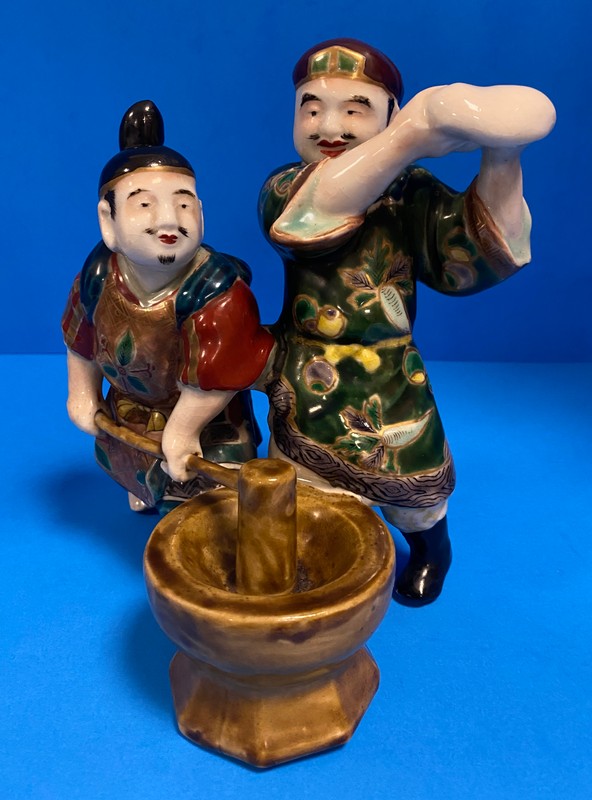
If you look closely, you will see the "thousand faces" design in this Kutani plate.
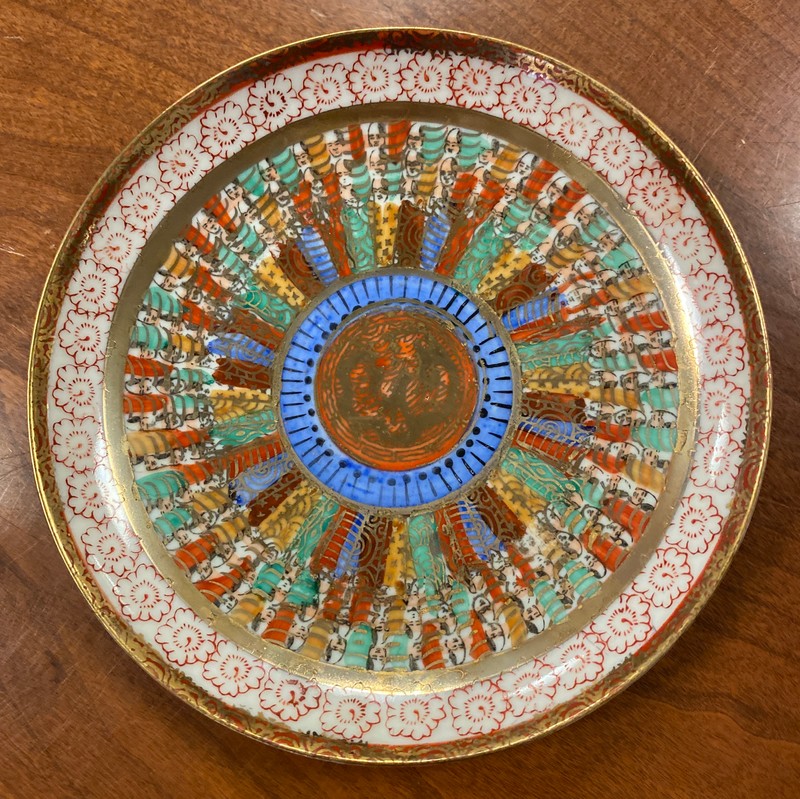
The delicate overglaze painting and very white underglaze demonstrate the classic Kakiemon style.
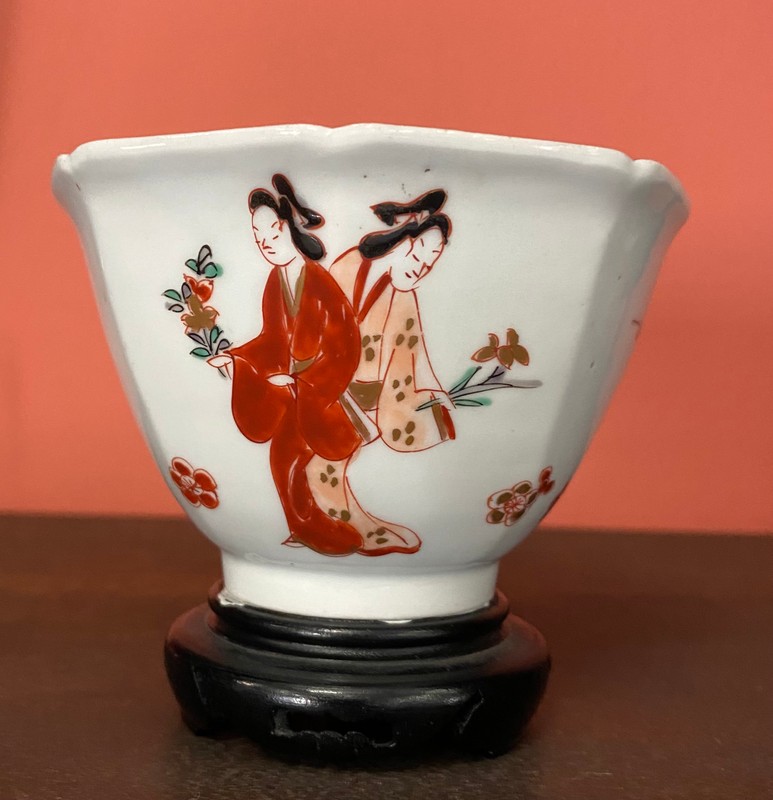
The reverse of the Kakeimon cup is as beautiful as the front.
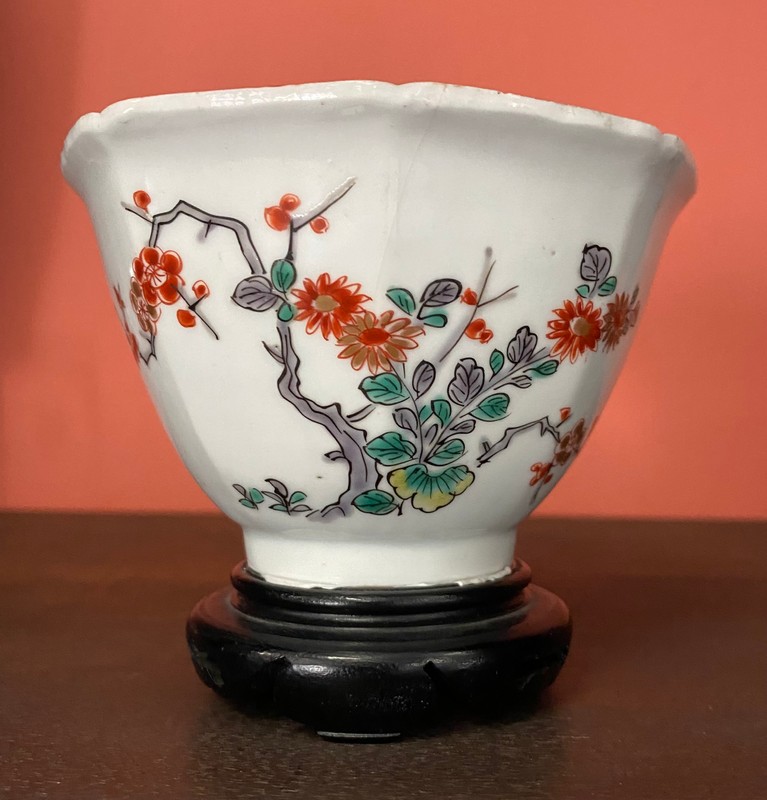
This Imari vase was painted by a Kakiemon artist.
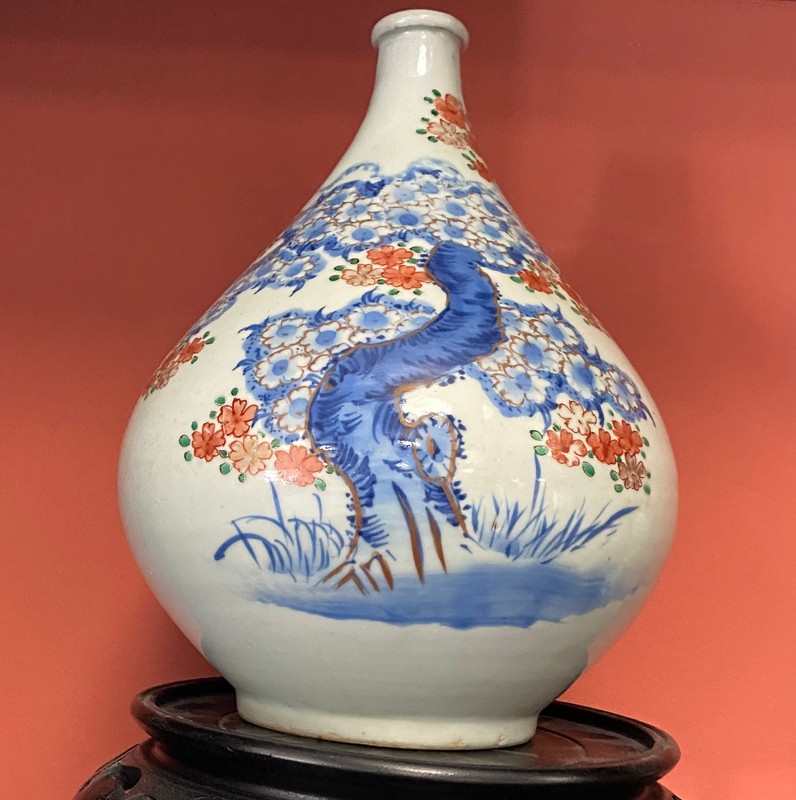
A porcelain brush pot, made in a Mikawachi kiln, would have been shipped from the port of Hirado.
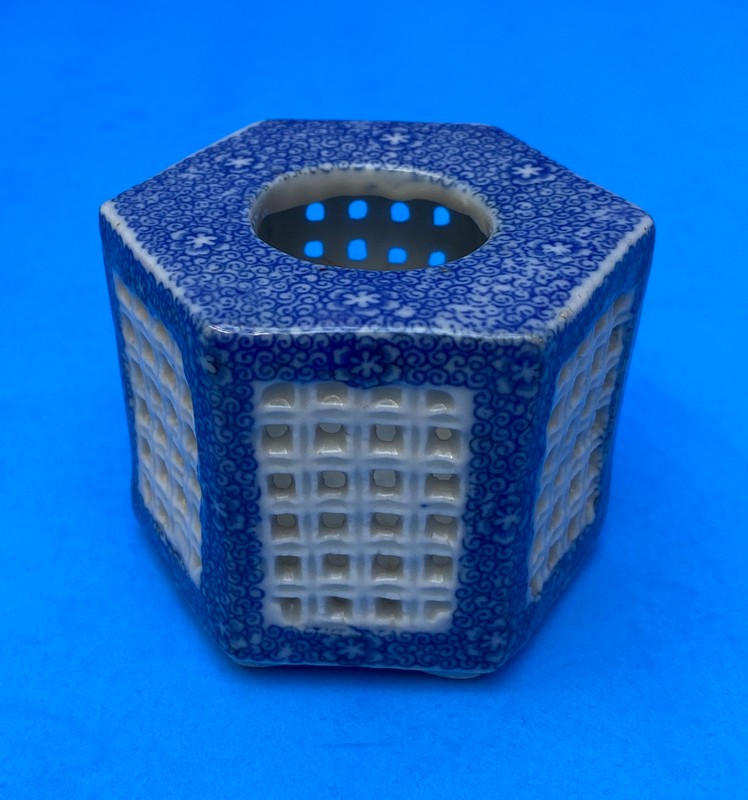
The rare openwork visible in this censor is made possible by Hirado's extremely fine porcelain clay.
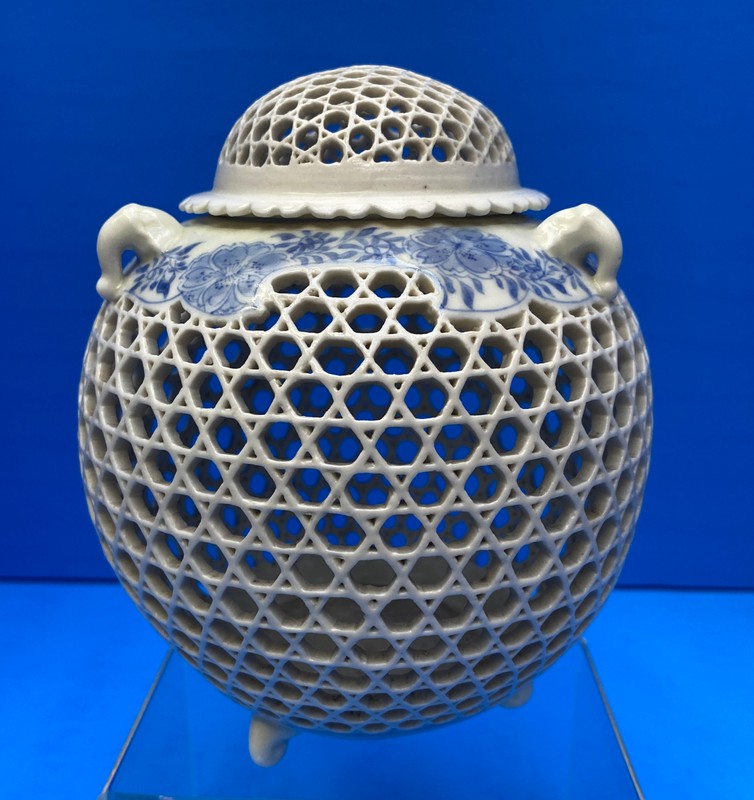
This Hirado incense burner features blue butterflies and gourds on pure white porcelain.
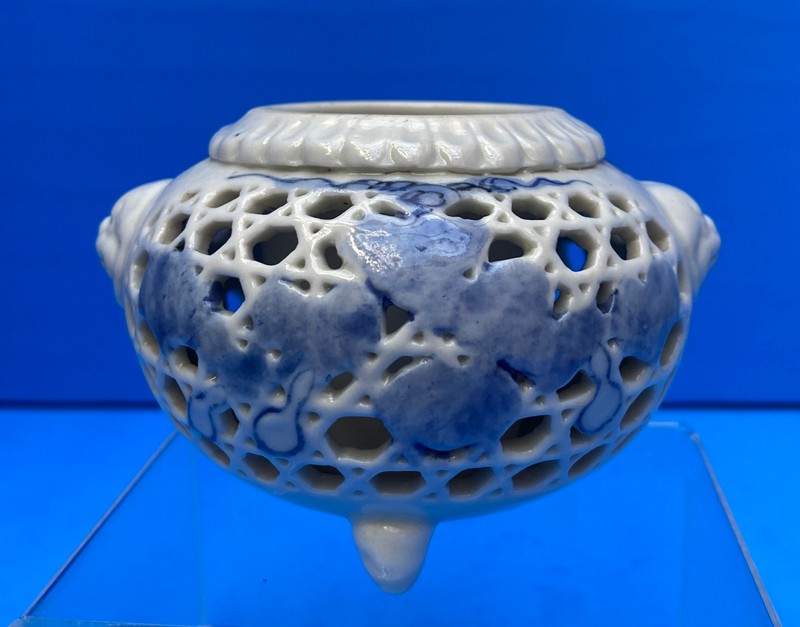
The tall form, blue and white glaze, relief figures, and delicate openwork make this an especially elegant artifact.
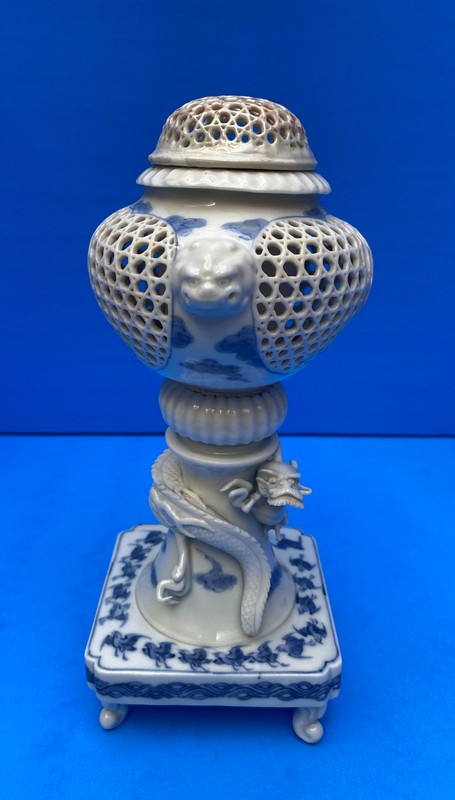
The Hirado porcelain incense burner is shaped as a Minogame, a legendary horse that became a tortoise.
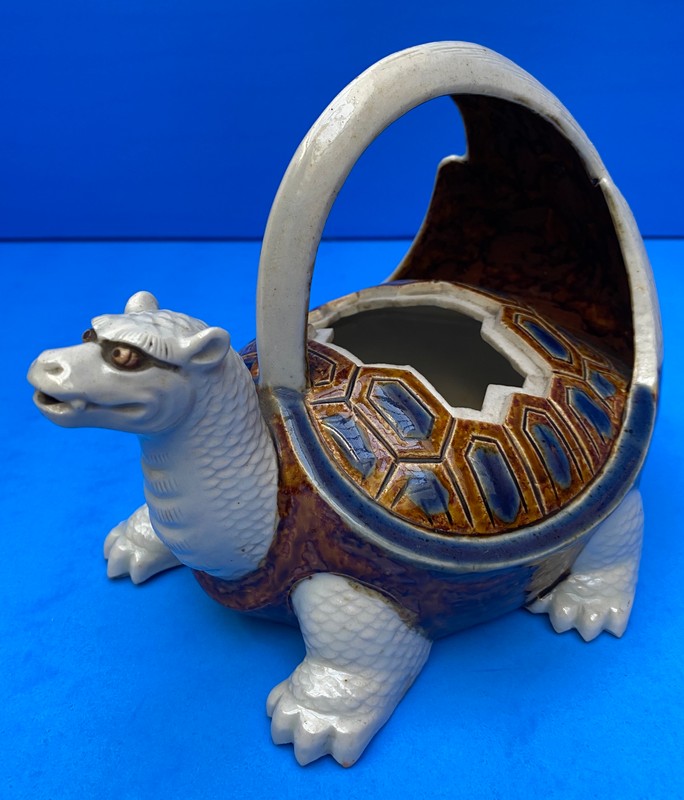
Brown glaze, a hallmark of Hirado, is on the top half of this vase, with its lower half in blue and white.
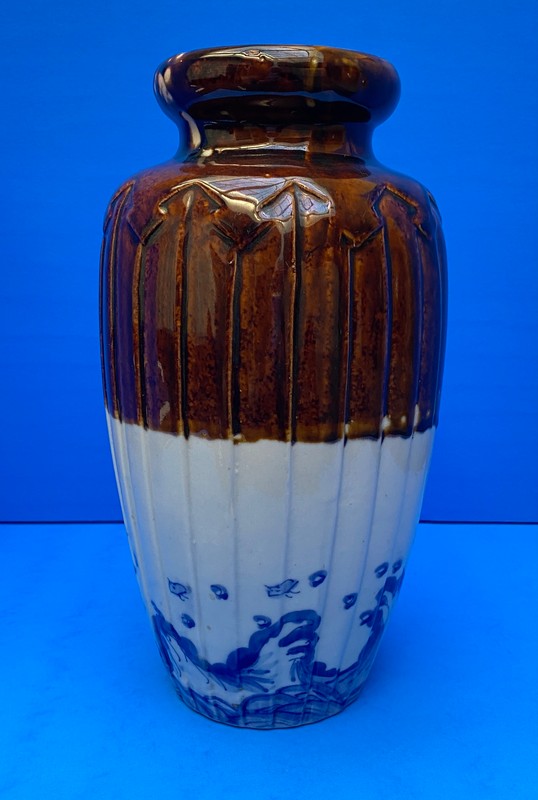
This Koto porcelain vase with irises is signed by Shozan Okamura.
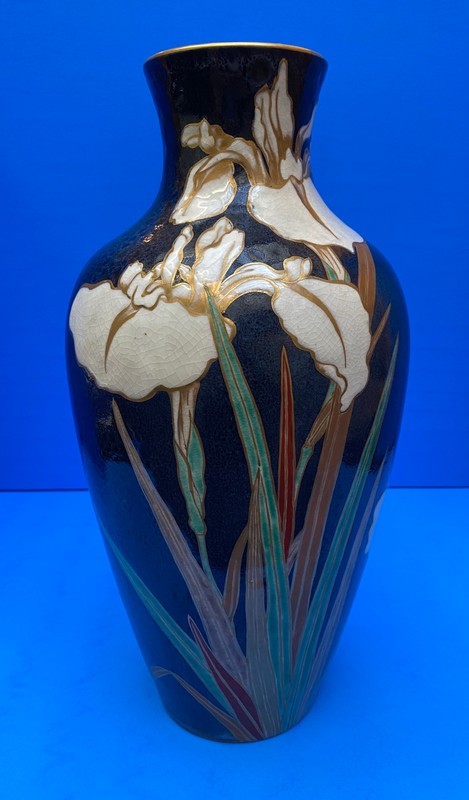
These Chinese celadon pieces in the Schaffner case demonstrate the various shades of green and types of crackle glaze.
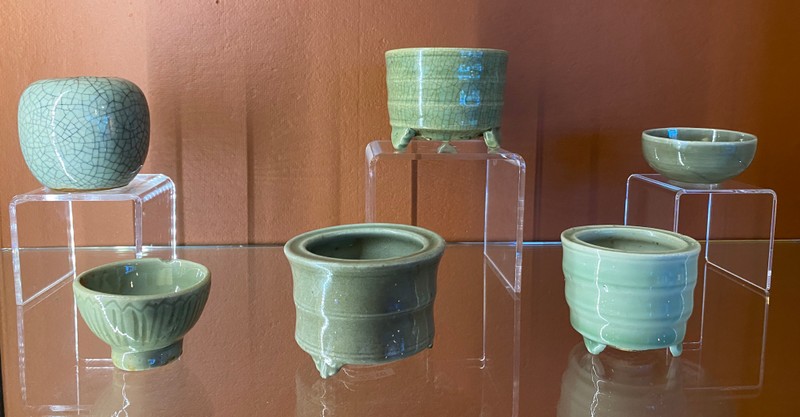
Vibrant colors and traditional forms make these vessels beautiful without pictorial decoration.
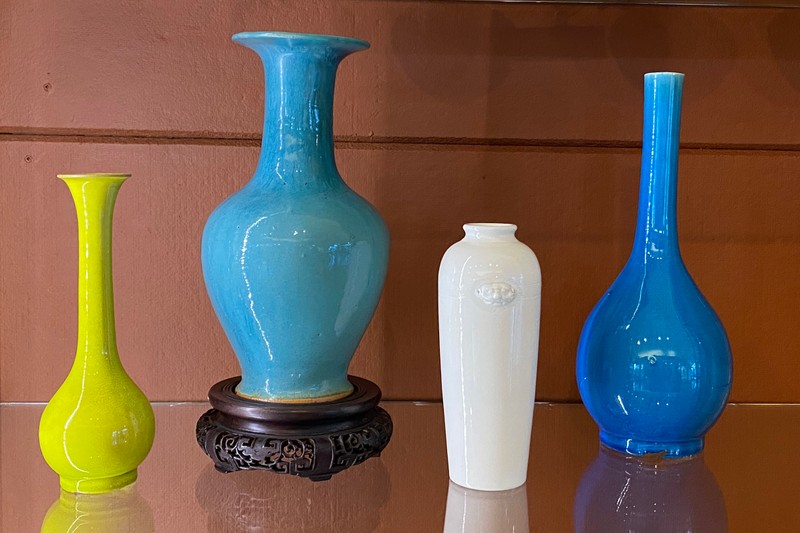
Chinese famille rose porcelain dinnerware from Canton is found both in the Schaffner case and the Breslauer room.
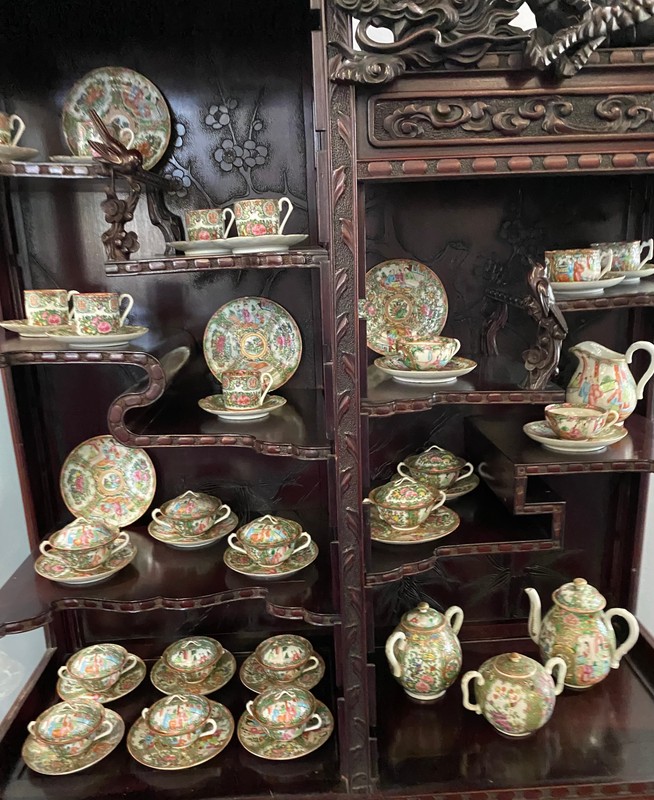
This Korean porcelain celadon bowl in the Lois and James Pott case has a delicate white inlaid design of birds and flowers.
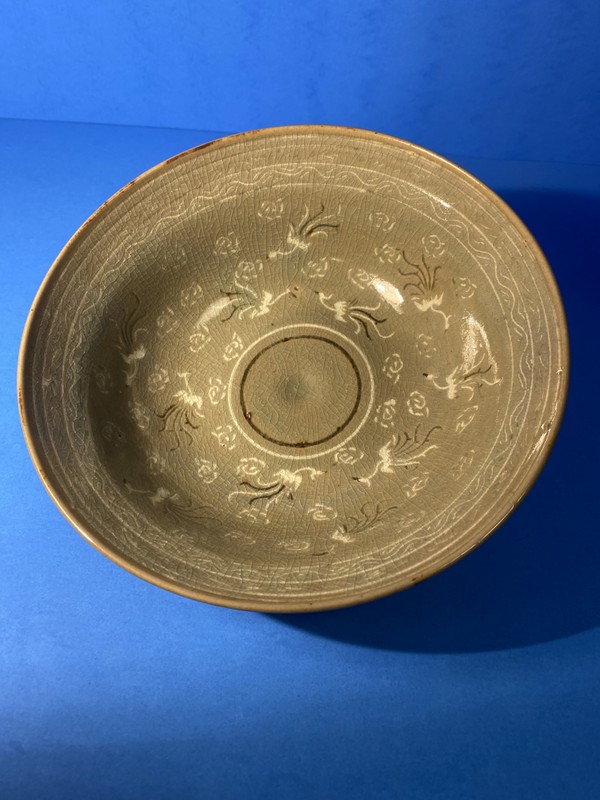
This Korean celadon jar is from the Kwangju kilns in the mid-Yi period (1600s).
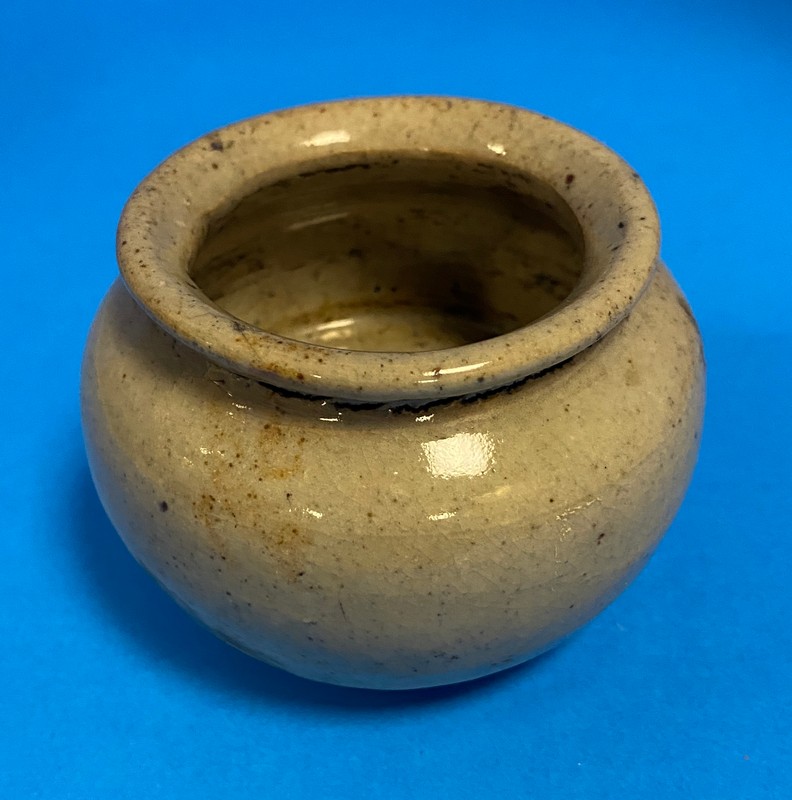
Near the Korean celadon in the Pott case, a collection of ceramics showcases the vibrant cobalt blue and pure white so popular in Asian ceramics.

Backstory and Context
Text-to-speech Audio
One of the most unique aspects of Japanese ceramics is the high esteem in which the tradition has been held for centuries, due in part to the continued influence of the tea ceremony and its many ceramic implements. Even today, ceramics remain at the forefront of Japan's artistic culture. This art is so revered in Japan that major ceramic artists have been given the title “Living National Treasure” to honor their excellence in traditional crafts...
Many steps and decisions go into making ceramics: what kind of clay to use, whether to hand form, mold, or use a potter's wheel; how long to fire the raw pottery in the kiln; and what decorative elements to include at various stages. There are three basic categories of ceramics: earthenware, stoneware, and porcelain. These are differentiated primarily by the firing temperature required in the kiln to harden each type of clay. The collection includes examples of all three, most dating from the late 1800s. Beautiful ceramics have been produced using all of these clay types, and all three continue to be used today for their unique characteristics...
[1] Earthenware is pottery made from a natural clay that has been fired at low temperatures. With one firing in the kiln, it is opaque, slightly porous, and coarser to the touch than stoneware and porcelain. When a transparent glaze is spread on the surface and a second firing done, it can be made glossy and waterproof. Terra cotta is a common example...
[2] Stoneware is pottery made from heavier clay than either earthenware or porcelain. It doesn't have any stone in it, but gets its name from its dense, stone-like quality. Its excellent reputation for dinnerware is built on its durability, a result of firing at high temperatures. Unlike earthenware, it does not need to be glazed to be waterproof, but glazing is used to add color and decoration...
[3] Porcelain is made from a white clay containing kaolin. When fired at very high temperatures, kaolin clay produces a smooth, hard, and semi-translucent ceramic that resonates when struck. It is typically used for fine china. Porcelain was fully perfected in 13th century China, and when Marco Polo saw it, he named it porcellana, an Italian nickname for the cowry shell’s smooth, white surface. Like the cowry, thin porcelain has an eggshell glow when held up to the light. Japanese kaolin clay deposits were only discovered in the early 16th century which marks the beginning of the Japanese porcelain market.
Clay body type is only one way to identify pottery. Japanese pottery is also discussed in terms of its geographic origin and the period in which it was produced. Additionally, some pottery is recognized by an artist's family name, or by a characteristic technique used, or still others by the port from which it was shipped, as in the famous case of Imari/Arita. These details are what make collecting Japanese ceramics so interesting. Examples from eight different kilns are on display in the Kathrine and James Lingle Display Case near the office: Bizen, Raku, Mishima, Satsuma, Imari, Kutani, Kakiemon, and Hirado. The bottom shelves of the last two cases will have rotating exhibits...
Bizen: Its famous kiln is a Designated Japan Heritage Site of the sixth century...
Bizen, also called Imbe, has been made continuously in the small town of Imbe in Bizen province since at least the sixth century. The Bizen kiln has been recognized as one of the Six Ancient Kilns for having passed down techniques from medieval times to today. Its wares look very raw and natural. Bizen ware has a dark gray stoneware clay body that turns brick-red, brown, or deep bronze. The surface can be matte or shiny glazed, with splashes of greenish or yellow glaze on some. Its unusually supple clay fostered its use for decorative pottery forms including sake bottles, tea ceremony implements, and even utilitarian tiles. The taller sake bottle on display has Chinese writing on it, possibly to make it look older and more valuable...
Raku: This age-old technique is still practiced in Japan and now around the world...
Raku got its name from a famous historical event. In 1588 a Korean family in Japan introduced a type of glazed earthenware covered with a lead glaze and fired at a comparatively low temperature. When they started making tea bowls, the samurai ruler Toyotomi Hideyoshi awarded them a gold seal engraved with the word raku, meaning felicity. Raku made in Kyoto is among the most famous of all Japanese wares. The classic tea bowl shape is hand-molded, usually with wide, straight sides set on a narrow base. The wall of the bowl is thick so that it does not become too hot to handle. The first glazes were dark brown; other colors came into use later. The characteristic results of the Japanese way of producing raku ware come from firing in the kiln at a low temperature, removing the object from the oven while hot, and cooling it in the open air...
Mishima: The rough and uneven technique used to make Mishima epitomizes wabi sabi...
Mishima ware is defined as “a brownish glazed earthenware marked with white lines.” Originating in China in the Tang dynasty (618-907), the design is incised or cut in the vessel after one firing. The deep-cut lines are filled in with diluted white clay (slip), glazed, and the vessel fired again. It is called Mishima because the designs the Korean Yi dynasty used in its tea ceremony reminded the Japanese of pre-Gregorian lunar calendar designs that came from the Mishima shrine in Shizuoka Prefecture, Japan. The large bowl is signed by Takahashi Dohachi, but there have been at least seven generations with that name beginning in 1740. It would be interesting to know which one created this masterpiece...
Satsuma: Not intended for practical use, it is collected as a unique form of art...
The Satsuma kiln was started in the early 16th century by Korean potters making simple earthenware tea ceremony implements with a heavy, dark glaze. This Ko-Satsuma lasted until around 1800 when a totally new Satsuma earthenware product was introduced. Called Kyo-Satsuma, it featured colorful enameling on a cream-colored ground with a crackled transparent glaze. It was decorated with brocade textile designs and gilt, and became very popular. Beginning in the 1850s, artists developed more complex designs and extravagant enameling and gilding to appeal to the tastes of Europeans. Sales must have been good because historians suggest that Satsuma wares financed the overthrow of the Tokugawa Shogunate. The Satsuma daimyo led the military alliance that restored power to the Meiji emperor in 1868. Sales peaked around 1885, but by the late 1980s only a few factories remained in production...
Collectors seek Satsuma for its exquisitely painted decoration, which is usually of intricate and minute Japanese figures and landscapes as on the bowl with the figures in a garden. Another decorative method seen in Satsuma is French moriage, or raised enamel, which adds a luxurious, third dimension to the surface. A good example is on the gold platter—the white flowers in the center are in moriage. Since there is no top glaze, the finished artistic effect is markedly different from overglazed porcelain with its smooth protective layer. Although typical Satsuma is earthenware, some porcelain bodies like the small incense burner were also decorated by Satsuma artists...
Imari: Arita kilns were the first to produce porcelain from newly discovered kaolin clay...
Porcelain created in the Arita kilns was shipped from the port of Imari which caused the two terms to be used interchangeably. Shipments of early Imari ware were mostly painted blue on white in imitation of Chinese ceramics, but the style popularly known today as Imari was born when Korean craftsmen discovered kaolin porcelain clay in Arita in the early 1600s. Porcelain requires very high temperatures, and the potters developed an advanced type of continuous step-chamber kiln which made increased production possible. The strict monopoly policies of the Saga daimyo lord also protected them. Porcelain manufacturing soon became a major Arita industry with many independent kilns. In the 1640s, at the suggestion of Dutch traders, a design of brocade textile patterns inside compartments, together with pictorial motifs, was adopted. This “old Imari” had sumptuous colors of rust-red, blue, green, and gold, with designs that covered the vessel completely. The effect was striking. The Dutch East India Company shipped this style of Arita ware in crates marked “Imari,” and by the mid 17th century, Imari was the leading export porcelain from Japan...
Notice the variety of different styles, not only in the Lingle case, but also in the LaJuana Rudy Room. Of special note, the rabbit bowl, with its dragons and phoenixes, may have been a wedding present to assure the new couple of good fortune and many children. Perhaps the turtle bowl was also a gift since its crane, pine, and plum blossoms are symbols of happiness, good fortune, and longevity...
Kutani: Bold designs and opulent enameling distinguish the Kutani kiln...
Old Kutani began production in 1656 in a kiln in Kutani, a small town in the Kaga mountains. The kiln used an underglazed porcelain body with the new multi-colored enamel overglaze. Unique in form, glazes, and decoration, Old Kutani is considered one of the best enameled ceramics made anywhere. When “porcelain fever" swept Japan in the 19th century, the general designation Kutani was applied to a wide range of wares produced in kilns that sprang up all over the valleys of Kaga province. Driven by an insatiable home market, new investors opened small workshops, and Kaga kilns had two advantages. They were very near kaolin porcelain clay deposits and close enough to Arita to obtain technical training. A revival of the Old Kutani styles came in the 1820s when a new kiln was opened. By the 1890's technical advances and Western-style pigments made Kutani ware a major export item...
Our collection contains a unique variety of Kutani styles, from the charming folk figures of Ebisu and Daikoku pounding rice to the elaborate “Three Warriors” bowl. The incense burner below the hanging scroll looks nothing like the other two; however, appraisers have identified them all as Kutani...
Kakiemon: This family kiln produced Japan’s first enamel overglazing on porcelain...
In 1656, Sakaida Kakiemon was one of the first Japanese potters to master the technical difficulties of enamel overglazing on porcelain. Nobody knows for sure how he did it, but one story is that he learned the secret from a chance meeting with a Chinese person in Nagasaki. His method was to apply an underglaze to the porcelain body and fire the piece once. He then painted his decoration on it with enamel pigments and fired the piece for a second time. This allowed the pigments to melt, bond, and turn translucent as the colors also changed, making the now “enameled” piece almost luminous. His decoration was in a purely Japanese style, with large areas of white ground with delicate flowering plants and fruits in soft red, yellow, blue, and turquoise green. It was exported to Europe by the Dutch East India Company and became so popular that European porcelain factories copied it. Notice the precise lines and exquisite colors on the bowl with two Japanese women on the front and flower blossoms on the back...
In 1971 the Japanese government designated the historic craft technique Kakiemon devised an Important Intangible Cultural Property, and a double climbing kiln in Arita used to fire Kakiemon has been designated a National Historic Site. Sakaida Kakiemon XIV was named a Living National Treasure and his son, Sakaida Kakiemon XV became the new head of the business in 2014...
Hirado: The fragile blue and white porcelain openwork is becoming increasingly rare...
Hirado is another of those wares better known by its port of Hirado instead of its Mikiwachi kiln, located in Sasebo City on the island of Hirado. It is believed that the kilns were established by a Korean potter named Ko Seki brought back by the daimyo lord of Hirado after the Imjin war in 1598. This war was also known as the “Porcelain War," since the many Korean potters who were brought back to Japan at that time had a major impact on Japanese wares. In 1751, the kilns were under the patronage of Matsura, Prince of Hirado. Succeeding generations used it for their exclusive use, producing some of the finest porcelains ever made in Japan...
The Hirado kiln made the pure white, as well as the blue-and-white, wares for which they were famous until 1843, when Matsura patronage was lost and replaced by export contracts with the Dutch East India Company. Typically, the extremely white porcelain was painted with a delicate underglaze blue of landscapes or figures. They also used relief decoration and some colored glazes, in particular dark brown. Hirado porcelain clay has a finer grain than most porcelains, which allowed for very thin and complicated openwork pieces, several of which are highlights of the collection...
Chinese Ceramics...
The Howard and Asian Art Collection has several pieces of Chinese ceramics in the Elynna and Henry Schaffner Display Case. In the first section on the left are several vases of fine Chinese porcelain with bright coloring. Further to the right, are examples of six small celadon bowls grouped together, and a seventh, Margaret Howard’s favorite celadon piece, under her portrait. Celadon is a particular shade of green, like celery, that has been popular in Asian ceramics throughout the ages. The Schaffner case also has selections from our set of famille rose fine china. More of that pattern can be seen in one of the cabinets in the Breslauer Family Foundation Chapter Room...
Korean Ceramics...
Currently, there are only two pieces of Korean ceramics in the collection. Korean styles and Korean potters had significant influence on Japanese ceramics. Look at the two Korean celadon porcelain bowls in the first section of the Lois and James Pott Display Case in the hallway...
Sources
"Hirado Porcelain of Japan from the Kurtzman Family Collection." Asianart.com. November 2, 2000. Accessed June 27, 2023. https://www.asianart.com/exhibitions/hirado/index.html
Moes, Robert. Quiet Beauty: Fifty Centuries of Japanese Folk Ceramics from the Montgomery Collection. Alexandria, VA . Art Services International, 2003.7
Nakagawa, Sensaku and Bester, John. Kutani Ware. New York, New York. Kodansha International, LTD. and Shibundo, 1979.
Simpson, Penny and Sodeoka, Kanji. The Japanese Pottery Handbook. New York, New York. Kodansha International, 1979.
Gorham, Hazel H.. Japanese and Oriental Ceramics. Rutland, Vermont. Charles E. Tuttle Company, Inc., 1971.
Boger, Louise Ade. The Dictionary of World Pottery and Porcelain. New York, New York. Charles Scribner's Sons, 1971.
Roberts, Laurance P. A Dictionary of Japanese Artists: Painting, Sculpture, Ceramics, Prints, Lacquer. New York, New York. John Weatherhill, Inc., 1980.
Tong, Emily. "Nine Most Notable Styles of Japanese Ceramics." Michelin Guide. July 1, 2019. Accessed July 26, 2023. https://guide.michelin.com/hk/en/article/travel/know-the-japan-pottery.
"Satsuma ware, Kogei Japan: Traditional Crafts of Japan." July 1, 2017. Accessed December 4, 2023. https://kogeijapan.com/locale/en_US/satsumayaki/.
Gorlinski, Virginia. "Imari ware: Japanese Porcelain." Britannica. July 20, 1998. Accessed December 4, 2023. https://www.britannica.com/art/Imari-ware.
Bergsma, Randi. "The Differences Between Stoneware, Earthenware, and Porcelain." EHow.com. Accessed November 14, 2023. https://www.ehow.com/info_8099876_differences-between-stoneware-earthenware-porcelain.html
Tao. "How to Read Satsuma Marks." Satsuma Pottery. January 10, 2023. Accessed December 4, 2023. https://www.satsume-pottery.com/how-to-read-satsuma-marks.
Nilsson, Jan-Erik. "Qing Dynasty (1644-1912) Porcelain: A Short Introduction." Gotheborg.com. June 27, 1999. Accessed December 4, 2023. https://gotheborg.com/qa/qingblueandwhite.shtml.
"A Guide to Demystifying Reign Marks on Chinese Ceramics." CHRISTIE'S. April 16, 2023. Accessed November 9, 2023. https://www.christies.com/en/stories/reign-marks-on-chinese-ceramics-an-expert-guide.
"Collecting Guide: Ten Things too Know about Chinese Ceramics." CHRISTIE'S. August 19, 2023. Accessed November 9, 2023. https://www.christies.com/en/sories/ccollecting-guide-10-things...-about chinese-ceramics.
"Qing Dynasty, 1644-1911." National Museum of Asian Art. Accessed November 7, 2023. https://asia-archive.sl.edu/learn/for-educators/teaching-china-wi.
"Chinese Pottery." Encyclopedia Britannica. August 19, 2023. Accessed December 4, 2023. Https://britannica.com/art/Chinese-pottery.
"Japanese Pottery and Porcelain." WIKIPEDIA: The Free Encyclopedia. Accessed December 4, 2023. https://en.wikipedia.org/wiki/Japanese_pottery_and_porcelain.
Waither, Anne. "The A-Z of Japanese Pottery: 32 Most Popular Ceramic Styles." Japan Objects. November 20, 2013. Accessed December 1, 2023. https://japanobjects.com/features/japanese-pottery.
Howard Collection 24.02
Howard Collection 24.03
Howard Collection 24.29
Howard Collection 24.11
Howard Collection 24.14
Howard Collection 24.15
Howard Collection 24.16
Asian Art Collection 24.53
Asian Art Collection 25.44
Asian Art Collection 25.04
Asian Art Collection 25.06
Asian Art Collection 25.38
Asian Art Collection 25.47
Howard Collection 25.25
Asian Art Collection 25.46
Howard Collection 25.35
Howard Collection 25.12
Howard Collection 25.12
Howard Collection 25.08
Howard Collection 25.10
Howard Collection 25.02
Howard Collection 25.39
Howard Collection 25.24
Howard Collection 25.36
Asian Art Collection 25.48
Howard Collection 25.23
Howard Collection 25.23
Howard Collection 24.41
Howard Collection 25.18
Howard Collection 25.28
Howard Collection 25.27
Howard Collection 25.01
Howard Collection 23.05
Howard Collection 24.26
Asian Art Collection 24.45
Howard Collection
Howard Collection
Howard Collection 22.22
Howard Collection 27.01
Howard Collection 27.03
Howard and Asian Art Collection
